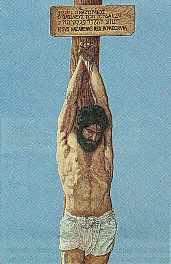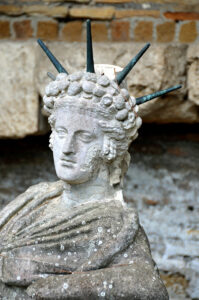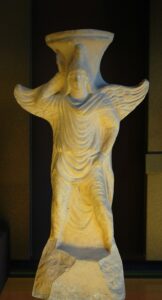
JESUS ON HIS CROSS ….. NOT!!!!! … IT DID NOT HAPPEN
Never did the Romans ever crucify anyone on a cross!!!!!!
The “crucifixion” device (Ha) used by the Romans was a “stauros.” A stauros was a mere large tall stake. It was used to execute criminals and other unwanted people. It used in various methods.
It was sometimes was pointed used by thrusting it through a persons body and thus pinning him to the earth to die painfully for everyone to see. Sometimes they would put the person at the top with the point at the stomach, and as time went on the point would pierce the stomach and eventually kill the person.
The most common was just to tie the hands up at the top of the stauros and let the person die of exposure and dehydration. There is no accounts of people being nailed to the stake.
There is no evidence whatsoever that a cross or even a T shape was used. There is no depiction of a cross until the 5th century. The first common usage of a crucifix was in the 7th century. Before that time Jesus was always depicted as a fish, or as a shepherd … and never on a cross.

THE STAUROS
The Imperial Bible-Dictionary acknowledges this, saying: “The Greek word for cross, [stau‧ros′], properly signified a stake, an upright pole, or piece of paling, on which anything might be hung, or which might be used in impaling [fencing in] a piece of ground. . . . Even amongst the Romans the crux (from which our word cross is derived) appears to have been originally an upright pole.”
Acts 5:30 and Acts 10:39 as examples of the correct translations.
The God of our fathers raised up Jesus, whom ye slew and hanged on a tree. Acts 5:30
39 And we are witnesses of all things which he did both in the land of the Jews, and in Jerusalem; whom they slew and hanged on a tree: Acts 10:39
In those verses KJ, RS, JB, and Dy translate xy′lon as “tree,” A Greek-English Lexicon, by Liddell and Scott (Oxford, 1968, pp. 1191, 1192).
Before Jesus, the Greek Bacchus, the Tyrian Tammuz, the Chaldean Bel, and the Norse Odin, were all symbolized to their votaries by a cruciform device.”—The Cross in Ritual, Architecture, and Art (London, 1900), G. S. Tyack, p. 1.
In ancient Israel, unfaithful Jews wept over the death of the false god Tammuz. Jehovah spoke of what they were doing as being a ‘detestable thing.’ (Ezek. 8:13, 14) According to history, Tammuz was a Babylonian god, and the cross was used as his symbol.
“The shape of the [two-beamed cross] had its origin in ancient Chaldea, and was used as the symbol of the god Tammuz (being in the shape of the mystic Tau, the initial of his name) in that country and in adjacent lands, including Egypt. By the middle of the 3rd cent. A.D. the churches had either departed from, or had travestied, certain doctrines of the Christian faith. In order to increase the prestige of the apostate ecclesiastical system pagans were received into the churches apart from regeneration by faith, and were permitted largely to retain their pagan signs and symbols. Hence the Tau or T, in its most frequent form, with the cross-piece lowered, was adopted to stand for the cross of Christ.”—An Expository Dictionary of New Testament Words (London, 1962), W. E. Vine, p. 256.
“Various objects, dating from periods long anterior to the Christian era, have been found, marked with crosses of different designs, in almost every part of the old world. India, Syria, Persia and Egypt have all yielded numberless examples . . . The use of the cross as a religious symbol in pre-Christian times and among non-Christian peoples may probably be regarded as almost universal, and in very many cases it was connected with some form of nature worship.”—Encyclopedia Britannica (1946), Vol. 6, p. 753.
IDOL WORSHIPING THE CROSS
Just taking the Christian Story as it is depicted by Christians, what type of person would feel they want to remember a torture of one of their dearest friends who was executed on the basis of false charges? What kind of person would make a replica of the instrument of execution?
The Christian Bible many times mentions “cross” or “crucify” and is furthering a myth and worshiping the false god Tannuz. Anyone depicting a cross as a symbol of a crucifixion is advertising a pagan religion.

FISH NOT CROSS … UNTIL 6TH CENTURY
Only was it until the late 5th century that genuine portrayals of Jesus on a crucifix were found, as before this time however, artifacts had all but depicted Jesus as the fish, or as the shepherd, but never on a Cross.
In the Greco-Roman world, from where Christianity later flourished, the most dominant cult (1000 BC) of a savior nailed upon a crucifix was that also of the pagan fertility god Osiris-Dionysus , who suffered persecution, died, and then rose again from the dead.
EIGHTH CENTURY ART
There are no early representations of Christ Jesus suffering on the cross. Rev. J. P. Lundy, speaking of this, says;
“Why should a fact so well known to the heathen as the crucifixion be concealed? And yet its actual realistic representation never once occurs in the monuments of Christianity, for more than six or seven centuries.”
Mrs. Jameson, in her “History of Our Lord in Art,” says:
“The crucifixion is not one of the subjects of early Christianity. The death of our Lord was represented by various types, but never in its actual form. “
The earliest instances of the crucifixion are found in illustrated manuscripts of various countries, and in those ivory and enameled forms.. Some of these are ascertained, by historical or by internal evidence, to have been executed in the ninth century, there is one also, of an extraordinary rude and fantastic character, in a MS. in the ancient library of St. Galle, which is ascertained to be of the eighth century. At all events, there seems no just grounds at present for assigning an earlier date
“Early Christian art, such as it appears in the bas-reliefs on sarcophagi, gave but one solitary incident from the story of Our Lord’s Passion, and that utterly divested of all circumstances of suffering. Our Lord is represented as young and beautiful, free from bonds, with no ‘accursed tree’ on his shoulders.”
On the authority of a Christian writer who has made the subject a special study, that, “there seems no just grounds at present for assigning an earlier date,” for the “earliest instances of the crucifixion” of Christ Jesus, represented in art, than the eighth or ninth century.
In regard to what these crucifixes looked like; If the reader imagines that the crucifixes which are portrayed to us this present day are similar to those early crosses, such is not the case. The earliest artists of the crucifixion represent the Christian Saviour as young and beardless, always without the crown of thorns, alive, and erect, apparently elate; no signs of bodily suffering are there.
On page 151, plate 181, of Jameson’s “History of Our Lord in Art” (vol. ii.), he is represented standing on a foot-rest on the cross, alive, and eyes open. Again, on page 330, plate 253, he is represented standing “with body upright and arms extended straight, with no nails, no wounds, no crown of thorns—frequently clothed, and with a regal crown—a God, young and beautiful, hanging, as it were, without compulsion or pain.” On page 167, plate 188, are to be seen “the thieves bound to their cross (which is simply an upright beam, without cross-bars [Stauros]), with the figure of the Lord standing between them.” He is not bound nor nailed to a cross; no cross is there. He is simply standing erect in the form of a cross. This is a representation of what is styled, “Early crucifixion with thieves.” On page 173, plate 190, we have a representation of the crucifixion, in which Jesus and the thieves are represented crucified on the Egyptian tau (see Fig. No. 12). The thieves are tied, but the man-god is nailed to the cross. A similar representation may be seen on page 189, plate 198. On page 155, plate 183, there is a representation of what is called “Virgin and St. John at foot of cross,” but this cross is simply an upright beam [Stauros](as Fig. No. 13). There are no cross-bars attached. On page 167, plate 188, the thieves are tied to an upright beam [Stauros](as Fig. 13), and Jesus stands between them, with arms extended in the form of a cross, as the Hindoo Crishna is to be seen in Fig. No. 8. On page 157, plate 185, Jesus is represented crucified on the Egyptian cross (as No. 12). Some ancient crucifixes represent the Christian Saviour crucified on a cross similar in form to the Roman figure which stands for the number ten [an X shape](see Fig. No. 14). Thus we see that there was no uniformity in representing the “cross of Christ,” among the early Christians; even the cross which Constantine put on his “Labarum,” or sacred banner, was nothing more than the monogram of the Pagan god Osiris (Fig. No. 15).

In the New Testament Novel what did the Romans use to kill Jesus?
A stake. The cross was not mentioned the bible originally. The KJV it was added to, but also it say a tree in another, so you can see it is not accurate. The encyclopedia say a stake also.I did some research here is what I found from encyclopedias.
If the Bible does not really say that Jesus was executed on a cross, then why do all the churches that claim to teach and follow the Bible—Catholic, Protestant, and Orthodox—adorn their buildings with the cross and use it as a symbol of their faith? How did the cross come to be such a popular symbol?
The answer is that the cross is venerated not only by churchgoers who claim to follow the Bible but also by people far removed from the Bible and whose worship far predates that of “Christian” churches. Numerous religious reference works acknowledge that the use of crosses in various shapes and forms goes back to remote periods of human civilization. For example, ancient Egyptian hieroglyphics and depictions of their gods and goddesses often show a cross in the shape of a T with a circle at the top. It is called the ansate, or handle-shaped, cross and is thought to be a symbol of life. In time, this form of the cross was adopted and used extensively by the Coptic Church and others.
According to The Catholic Encyclopedia, “the primitive form of the cross seems to have been that of the so-called ‘gamma’ cross (crux gammata), better known to Orientalists and students of prehistoric archæology by its Sanskrit name, swastika.” This sign was widely used among Hindus in India and Buddhists throughout Asia and is still seen in decorations and ornaments in those areas.
It is not known exactly when the cross was adopted as a “Christian” symbol. Vine’s Expository Dictionary of New Testament Words states: “By the middle of the 3rd cent. A.D. the churches had either departed from, or had travestied, certain doctrines of the Christian faith. In order to increase the prestige of the apostate ecclesiastical system pagans were received into the churches apart from regeneration by faith, and were permitted largely to retain their pagan signs and symbols,” including the cross.
Some writers point to the claim by the sun-god worshipper Constantine that in 312 C.E., while on one of his military campaigns, he had a vision of a cross superimposed on the sun along with the motto in Latin “in hoc vince” (by this conquer). Some time later, a “Christian” sign was emblazoned on the standards, shields, and armor of his army. Constantine purportedly converted to Christianity, though he was not baptized until 25 years later on his deathbed. His motive was questioned by some. “He acted rather as if he were converting Christianity into what he thought most likely to be accepted by his subjects as a catholic [universal] religion, than as if he had been converted to the teachings of Jesus the Nazarene,” says the book The Non-Christian Cross.
Since then, crosses of many forms and shapes have come into use. For example, The Illustrated Bible Dictionary tells us that what is called St. Anthony’s cross “was shaped like a capital T, thought by some to be derived from the symbol of the [Babylonian] god Tammuz, the letter tau.” There was also the St. Andrew’s cross, which is in the shape of the letter X, and the familiar two-beamed cross with the crossbar lowered. This latter type, called the Latin cross, is erroneously “held by tradition to be the shape of the cross on which our Lord died.”( jw.org)



